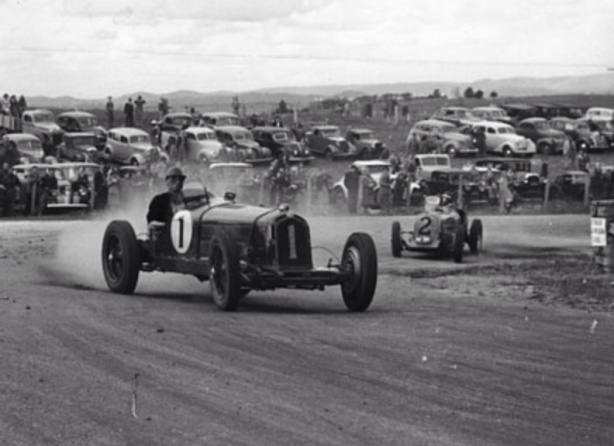
Alf Barrett leads Frank Kleinig, Alfa 8C2300 Monza and Kleinig Hudson Spl, Australian Grand Prix, Mount Panorama, Bathurst 1947…
This was the race within the race, these quite different cars were outright contenders but the AGP was a handicap Formula Libre event in those days, the race was won by Bill Murray in an MG TC, neither Barrett nor Kleinig finished.
Alf Barrett and the Monza were the fastest combination in the immediate pre and post-war periods in Australia, he was and is regarded as one of the country’s greatest drivers.
Noted motoring writer and journalist Mike Kable wrote in 1998 upon Barretts’ death, ‘Alf Barrett was known as the maestro. It was an appropriate nickname because of his achievements between and after World War 2 in a supercharged straight 8 Alfa Romeo 2300 Monza at his favourite circuit – Mount Panorama at Bathurst, New South Wales.’
‘The dapper Barrett drove the thoroughbred Italian car with world class finesse and flair with exceptional physical and mental coordination and intense concentration that enabled him to control sliding the car at its absolute limits with a calm smooth flick-of-the-wrist precision. Seeing the black-helmeted Barrett in action, sitting high in the cockpit, wearing his trademark dark blue short sleeved shirt was a never-to-be forgotten treat.’
‘In an era of self funded amateurs who drove for token prize money, the challenging 6.2 mile Mount Panorama circuit was the standard setter by which the best drivers were judged. Barrett became the master in 1940 with an against-the-odds victory in the New South Wales Grand Prix. The classic race was a handicap with Barrett starting from scratch position, many of his rivals had already covered several laps before he started. He went on with a stunning performance where he set a new outright lap record that made the ‘King of the Mountain’. He had started last and finished first’.


Barrett was born in 1908 to a well to do family in the affluent Melbourne suburb of Armadale. He and his brother Julian or ‘Gib’ inherited their father’s passion for cars. Before too long the boys were experimenting with all kinds of petrol powered devices in the large grounds of their home.
Not too far away a young mechanic, Alan Ashton, was serving his time as an apprentice at AF Hollins Motors, the three of them met and were messing around with cars and bikes which they tested at Aspendale Speedway. Alf and Alan built their first racing car, a Morris Bullnose Special in 1933, initially entering hillclimbs, it was competitive too, winning the Junior 50 and Winter 100 at Phillip Island in 1934.


Barrett then bought the ex-Jack Day Lombard AL3 in late 1935, and raced the car in his first Australian Grand Prix at Victor Harbor (correct spelling), in South Australia’s Fleurieu Peninsula on December 26, 1936.
It was the first AGP held outside Victoria and has been known over time as the 1937 AGP despite being held on Saturday 26 December 1936…and named when held as the South Australian Centenary Grand Prix. It seems this ‘corruption of history’ as historian John Medley called it, commenced in the 1950s, whence it originated nobody seems to know.
The Sporting Car Club of South Australia was formed in 1934 and played an active part in the celebration of 100 years of European settlement of South Australia, the piece de resistance of the organising South Australian Centenary Committee was SA’s first real road race held 50 miles from Adelaide on the Fleurieu Peninsula, only a few miles from the mouth of the mighty Murray River on public roads between Port Elliott and Victor Harbor, then as now a summer playground. The event was run over 32 laps, 240 miles.
The race attracted the best cars and drivers from all around Australia, the limit men of the handicap race drove MG K3s and Bugatti Types 37 and 43 and over 50,000 paying customers came to an event then a long way from Adelaide.
Barrett entered the Morris for Colin Anderson, his MG P type for Tim Joshua, driving the Lombard himself. He had a handicap of 21 minutes but lost a supercharger pop-off valve and failed to finish, Anderson’s Morris was delayed by overheating problems and was flagged off. Tim Joshua drove an exceptional race in the P-Type and was leading the event for some laps before a seven minute stop in the pits for unidentified maladies, he finished the race second behind the winning MG P-Type of Les Murphy.
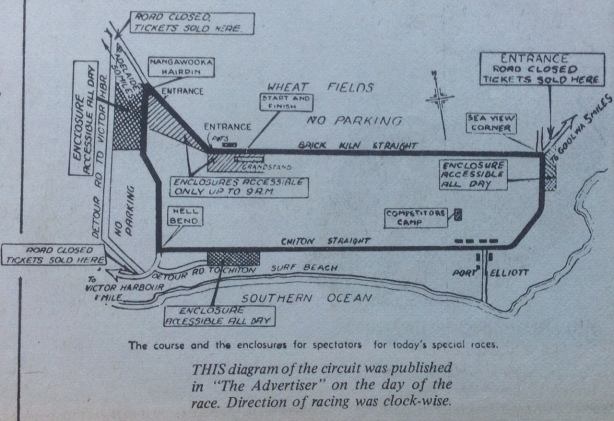
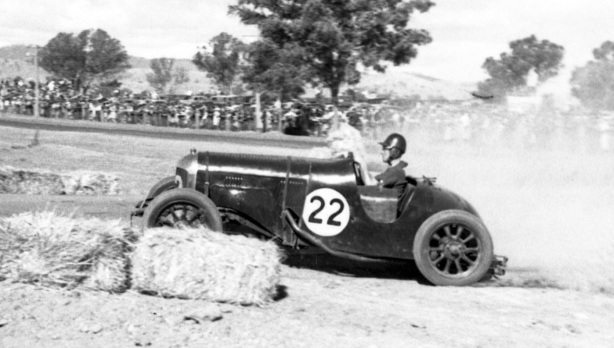
In the 1938 AGP Barrett again raced the 1927 Lombard but the Cozette supercharged car, running off 22 minutes, retired from the race held at Mount Panorama. Visiting Englishman Peter Whitehead won in his ERA Type-B off a very favourable handicap winning from Les Burrows’ Terraplane Spl.
As part of the Albury 150th anniversary celebrations a new 4.2-mile circuit was laid out on public roads at Wirlinga, an Albury suburb. Albury is a town on the Murray River on the New South Wales/Victoria border.
Barrett contested the Kings Birthday Grand Prix or Interstate Grand Prix – the event seems to have been attributed a variety of names – in the Cowley on 19 March 1938, it was won by local Wangaratta boy Jack Phillips in his self built Phillips Ford V8 Spl.

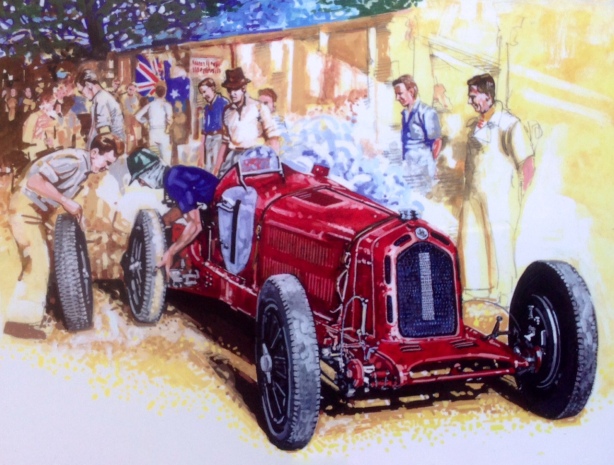

In late 1938 Barrett acquired and imported the Monza from the UK, it had been raced successfully there by AP ‘Ginger’ Hamilton.
Chassis #2211134 was built in 1932 and sold to Raymond Somner. He won the Marseilles Grand Prix at Miramas in September 1932 and several other events selling the car back to the factory, having acquired a Maserati for 1933. Hamilton bought it in late 1933 and raced the car extensively in the ensuing five years, there is a comprehensive record of the car’s competition record in Europe in at the end of this article.
I wrote about the design and specifications of the Alfa Romeo Monza in an earlier article so will not repeat that information here, click on this link to that article. https://primotipo.com/2014/10/09/antonio-brivio-targa-florio-1933-alfa-romeo-8c2300-monza/
When the Monza arrived in Australia it was prepared by Alan Ashton, he acquired a reputation as one of the most talented engineers in the country, fettling cars for Barrett until the end of his career and later Tony Gaze and then Lex Davison throughout his reign in the 1950s and 1960s as well as various international drivers who sought his talents.
The Alfa arrived in time for the last pre-war AGP held on the fast, daunting road course at Lobethal in South Australia’s Barossa Valley.
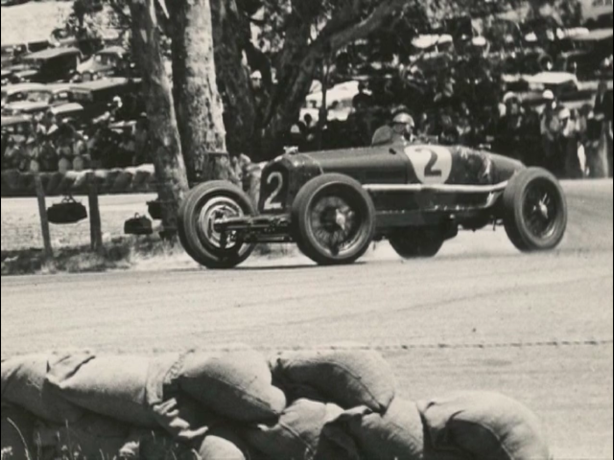
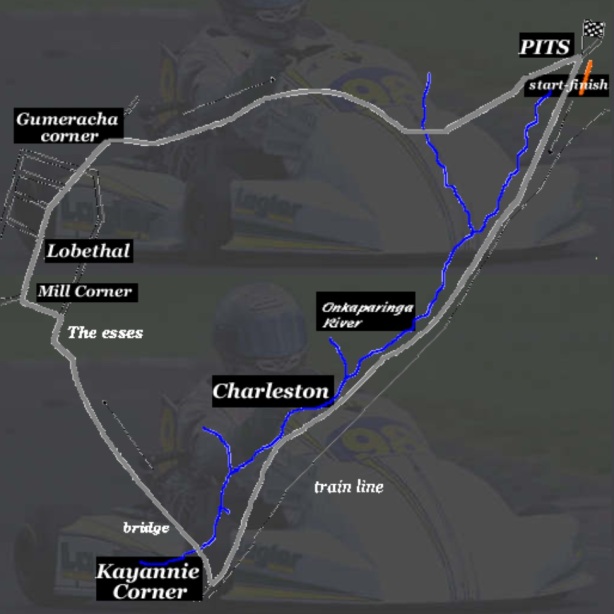



South Australian, Patrick Atherton in his website ‘Lagler Racing’ paints a vivid picture of the circuit, these are still public roads upon which you can drive thus…
‘From the old start-finish and grandstand area north of Charleston you could be forgiven for thinking it’s nothing special. No really challenging corners just sweeping curves. But put it into context; these cars had spindly wires and tyres, cart springs and beam axles and near useless drum brakes. These ‘curves’ are all blind. There are crests preceding all of them, particularly the bridges, which funnel into chutes. Think of these machines dropping on to their suspension in mid-air whilst turning at 100mph.
Through the little town of Charleston, with it’s pub (still there) the crowds were thick. Stories abound of drivers stopping, mid practice sessions for a pint or two.Out past here are frightening kinks, all blind, all crests and dips. Then a blind right hand kink sucks you into Kayannie corner, the tight right hander leaving Woodside Road and heading towards the township of Lobethal. Here the spectators got off the train from Adelaide straight into spectator areas at the side of the track, driver’s left.
The climb up the hill is significant, mostly straight for almost two km, but at the top, this track steals straight from the soul of Nurburgring. Lined by trees, the blind crest plummets away left, bottoms out right, drops away again, into a rollercoaster left. Then it flattens, raises slightly, then another drop into the braking area for the hard right hander (Mill corner) into Lobethal’s main street. Even the main street isn’t straight. Past the pub on the right there’s now a little ribbon of paving (Indianapolis-style) across the road and a plaque to commemorate the racing era.
Up the hill it funnels between shops and houses and then there is the blind, off-camber Gumeracha Corner, which claimed lives. The stretch from here to the start-finish hairpin has to be experienced. 5 km of crests, blind curves, feature changes and major undulation. Here is where the truly great drivers would have made up time on nothing more than sheer bravery. Indeed they did, and one in particular, winner Alan Tomlinson.’

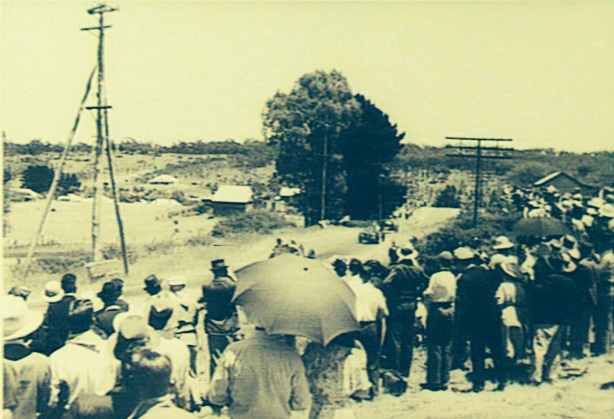
Jack Saywell had the car with the most potential, an Alfa P3 fitted with a 2.9-litre supercharged straight-eight, Barrett’s Monza, also designed by Vittorio Jano, had a less sophisticated 2.3-litre supercharged straight-eight. A big incident in practice involved Barrett’s avoidance of a slow moving MG, the Monza ran off the road at high speed, a rear wheel hitting a gutter and throwing the car high into the air before landing 20 metres down the road. Alf brought the car back under control, but the incident caused a bent back axle and buckled wheel, both of which were fixed by Ashton overnight. However, the wheelbase was two inches shorter on one side of the car than the other.
60,000 people attended the event, Barrett stalled at the start, losing five minutes in the process. He finished eighth, the handicap event was won in legendary fashion by Alan Tomlinson in a supercharged MG TA Spl.
Despite his handicap Tomlinson ‘punched way above his weight’, his preparation for the race was meticulous. He walked the circuit in the weeks prior to the event and drove around it in another TC practicing each section patrticularly the 5Km stretch from Gumeracha Corner to the Start-Finish hairpin, he knew that section would be key for a driver in a notionally slower car, if you were brave enough…Tomlinson was to say after the race that Saywell’s Alfa held him up on that stretch! Tomlinson returned to Lobethal in 1940 for the SA Trophy and almost lost his life in an horrific accident after colliding with another car, careering off the road through a wire fence, lucky not to be decapitated, and hit a tree. The young WA driver did not race again but lived into his 90s.
Check out this fabulous documentary on the short but sweet history of Lobethal road circuit…https://vimeo.com/83756140
The Monza quickly established lap records at Lobethal, Bathurst, Albury Wirlinga, Nowra, Ballarat and Point Cook. It’s last pre-war start was at Wirlinga in 1939, winning a short handicap and setting a lap record of over 90mph on the gravel course.
During WW2 Alf and Gib served in the RAAF, returning to racing after hostilities ceased,
in late 1946 the Monza was again race prepared.
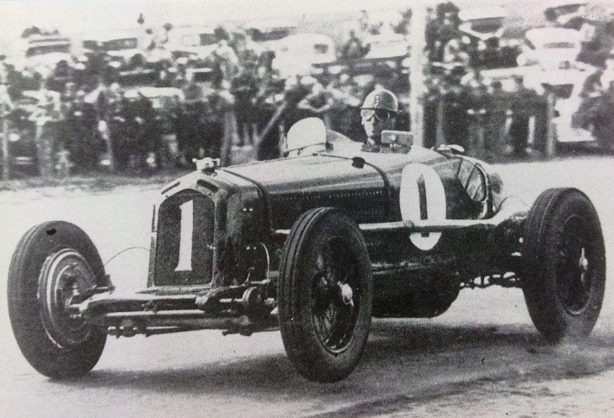
The first race meeting organised by the LCCA in Victoria was at Ballarat Airfield in February 1947, the RAAF made the facility available for creation of a road circuit.
Over 30,000 people attended the meeting which featured all of the stars of the day. Barrett thrilled the crowds with his driving and the sight and sound of the fabulous supercharged straight-eight engine. Alf didn’t beat the handicappers though, off scratch, he gave away 22 minutes to the limitman, Hollinshead’s MG J2, victory in the feature race, the Victorian Trophy went to Doug Whiteford in ‘Black Bess’, the Ford V8 Spl later to win the 1950 AGP.
This fantastic bit of footage shows both the Ballarat 1947 event and 1961 international meeting contested by Dan Gurney, Graham Hill and many others. Don’t be put off by the commentary, Barrett is driving his Monza not an Alfa P3. https://www.youtube.com/watch?v=J2uwd7m6UGo 
At Nowra, a new airstrip venue in June, Barrett won both the over 1500cc event and 110 mile NSW Championship in the Monza achieving both the fastest lap at 93mph and time, despite a pitstop.
Whilst motor racing recommenced post-war in Paris on September 9, 1945 the first post-war Australian event seems to be a hillclimb at Foleys Hill out of Sydney, whilst the AGP was not held until 1947 at Bathurst.
Despite problems with the police in getting the requisite permit and dissension in the ranks of the drivers, there were 29 acceptances and 22 race starters.
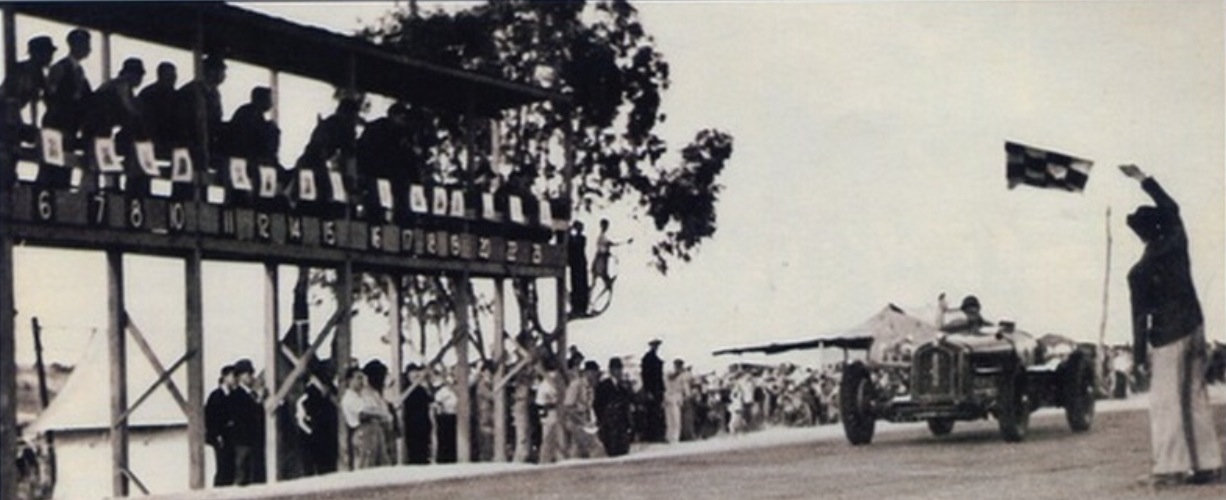
Barrett’s Monza was off scratch due to the absence of Saywell’s faster P3, it’s engine was dispatched by sea prewar to Italy for a rebuild, never to survive the voyage. Lex Davison entered a Mercedes SSK 38/250, the first of many successful AGPs for the Victorian, other fast cars included the Kleinig Hudson Spl of Frank Kleinig, Hope Bartlett’s Dixon Riley and Ewing’s Buick Spl.
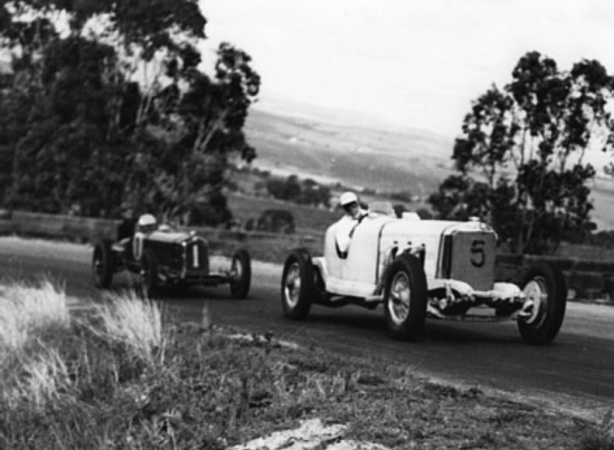
Practice was on the preceding Thursday and Sunday, Barrett enlivened proceedings by taking all and sundry for rides around Mount Panorama in the Monza, as did Lex Davison in his Merc complete with linen helmet, goggles, coat and tie!
Barrett gave away 37 minutes to the first car away, Alf lapping at 3:08 and 124mph down the ‘narrow, bumpy and spooky Conrod Straight between the trees’ but retired on lap 27 with valve insert trouble – he really didn’t ever have a surplus of AGP luck!, the race was won by Bill Murray’s MG TC.
‘Alf in his 8C2300 was the fastest driver in Australia in 1947’ according to John Medley but for 1948 the level of competition increased with Tony Gaze and Lex Davison importing a 2-litre supercharged Alta and Alfa Romeo P3/Tipo B respectively.
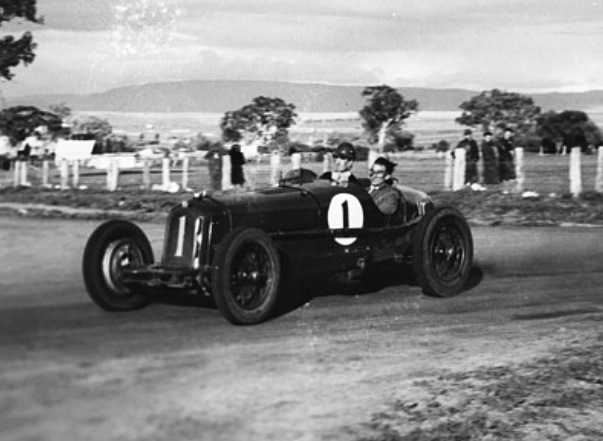
The 1948 AGP was held at Point Cook, it’s easy to forget the context of the post war times in a low key year for motor racing in Australia, John Medley in Cars and Drivers #3 wrote ‘The post war age of austerity with its restrictions and ration books still prevailed with a shortage of fuel, oil, paper, steel, food and power.’
’In fact fuel rations were tightened during the year which placed a limit on the number of events…The mainstay of Australian motor racing still remained the homebuilt sprecial, a few of them single-seaters but most two seaters used on the road with number plates and lights, and for racing.’
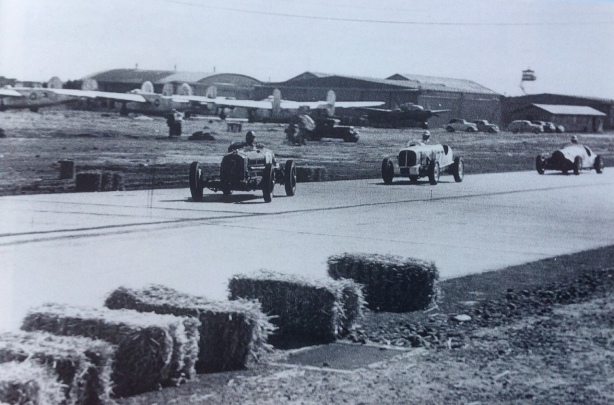
Point Cook is in Melbourne’s inner western suburbs, it was the first time the AGP was held at an airforce base and the first AGP not held on a course using public roads.
26 cars entered the event held on Australia Day, 26 January. It was over 42 laps of a 3.85 km circuit comprising airfield runways, taxiways and service roads, a total distance of 100 miles. Only 10 cars completed the race which was held in excruciating hot conditions, no shade was to be had on the desolate airfield. The handicap event, AGPs were not held as scratch events until 1951, was won by Frank Pratt a Geelong, Victoria motorcycle racer/dealer in a BMW 328.
Barrett started the race poorly having some issues which slowed him down then was the fastest car in the race for a while before withdrawing from the event with heat exhaustion on lap 22. He was far from alone, only 10 cars finished as stated above.
Alf contested the Easter Bathurst meeting which comprised some short handicap races, he didn’t win but set fastest lap in his Alfa, Gaze blew the Alta’s 2-litre engine and Davison retired early after troubles arising from a spectacular practice crash. The feature, handicap race, the NSW 100 was won by John Barraclough’s MG NE with a fine battle between the Barrett and Davison Alfas. Barrett in the older car broke the lap record at 3m 01 seconds with Davo recording 144mph down Conrod in the P3, a new straight line speed record at Mount Panorama.
Melbourne Cup Weekend in November seems to have been Alf’s final race with the Monza, winning his class at Rob Roy Hillclimb at the Australian Hillclimb Championship.
With a growing family and a business to run Barrett sold the Monza and retired from racing, not entirely though! He retired at the top, John Medley commenting about 1948 as follows…’Cars new to the scene included Lex Davison’s Alfa P3 and Tony Gaze’s two Altas with Alf Barrett’s Monza Alfa Romeo still the car to beat in major races’
The Monza passed into the hands of Rupert Steele in late 1949.
A Victorian, he was very quickly on the pace, his previous experience in a Bentley, practising the Alfa on the back roads between Beaconsfield and Dandenong to help get the feel of the fabulous machine.
He raced at Fishermans Bend, was sixth in the SA Championship at Nuriootpa in 1949 and put that practice to good effect in the 1950 AGP, which was also held on that quick road course in the Barossa Valley.
The race was still a handicap event, Steele finished second to Doug Whiteford’s Ford V8 Spl ‘Black Bess’ and shared the fastest lap with Whiteford who was a formidable driver with vastly more experience than Steele, albeit driving a much less sophisticated car. Black Bess was famously based on an ex-Victorian Forestry Commission Ute!
Steele didn’t own the Monza for long, later in life he became a notable Victorian in business and horse racing, the car was advertised again for sale.
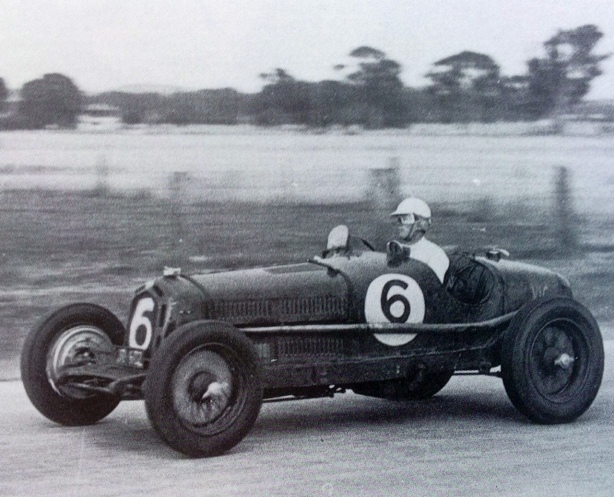
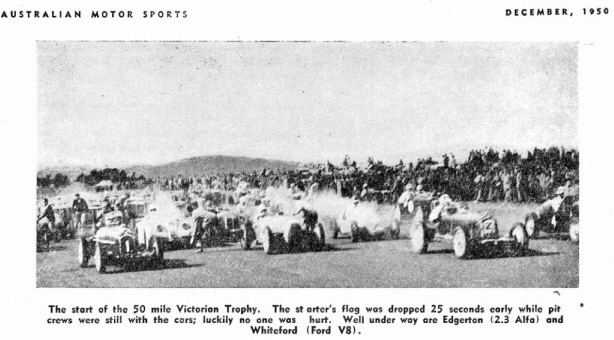

The next owner was Victorian ‘Racing Ron’, a very experienced driver who was very competitive in the Monza racing it around the country, an initial win at Ballarat Airfield in the 1950 Victorian Trophy against strong opposition was impressive.
The car raced at the Bathurst October meeting in 1951, finishing fourth in the ‘100’ and third in the 50 Mile Redex Championship, Edgerton’s year was capped with a fourth in class at the Australian Hillclimb Championship at Rob Roy, in Melbourne’s Christmas Hills.
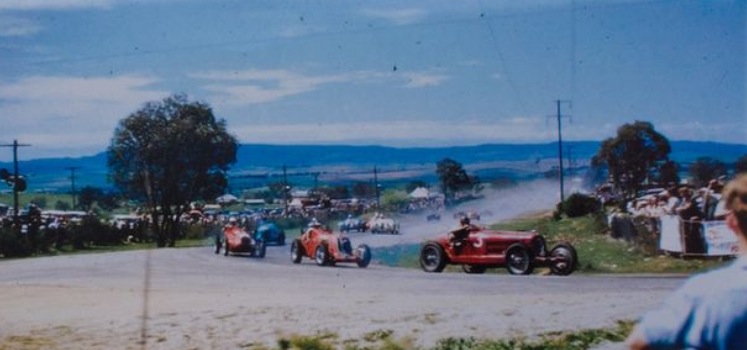
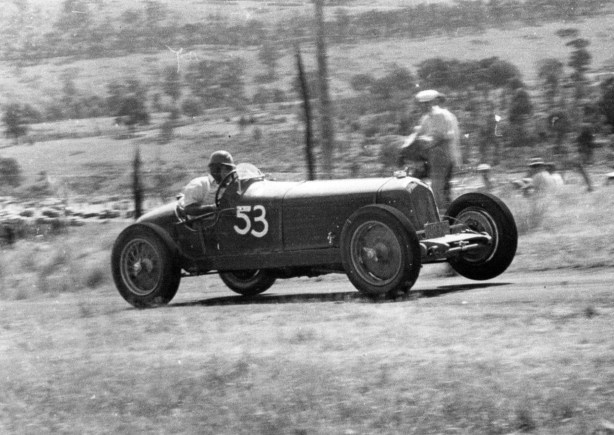
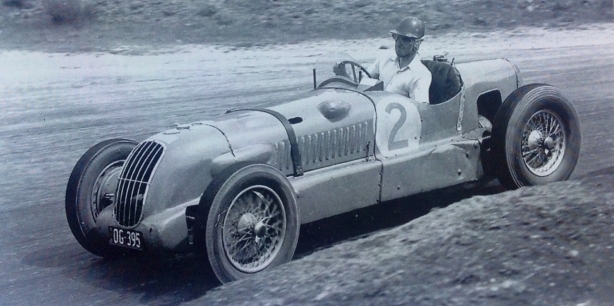
The Winter 2012 issue of Loose Fillings the wonderful Australian Newsletter about air-cooled racing cars had an article by the late lamented Australian Historian/Enthusiast/Racer Graham Howard.
‘He (Barrett) was at Bathurst in October 1951 as a spectator when offered a drive in Misha Ravdell’s Firth-prepared Mk4 Cooper Vincent… after Ravdell himself had been injured in a local road accident. Not having driven a racing car of any kind for more than a year and with no experience whatever of a Cooper-style car, he won a six-lap under 1500cc handicap and was well placed in the main event when he ran over a displaced sandbag and broke a driveshaft universal joint. He vividly remembered the Cooper’s vibration. ‘It was like driving a lawnmower– dreadful. You’d get out of it as if you’d been driving a lawn-mower.’ But everything else compared to his beloved Alfa was a revelation.
‘The Cooper made my hair stand on end. It ran so straight and it stopped straight. The brakes were like running into cotton wool. With the Alfa you always felt you were a foot off the ground and it would get such dreadful brake tramp. ‘The thing I noticed with the Cooper, it held on until all four wheels went together. You could go too far with the Alfa and cars like that, and they’d still hang on, the Cooper would just go snap. ‘But that little Cooper – it just went straight, it stopped straight. So when I say the Alfa was good, it was good-until the Cooper’.
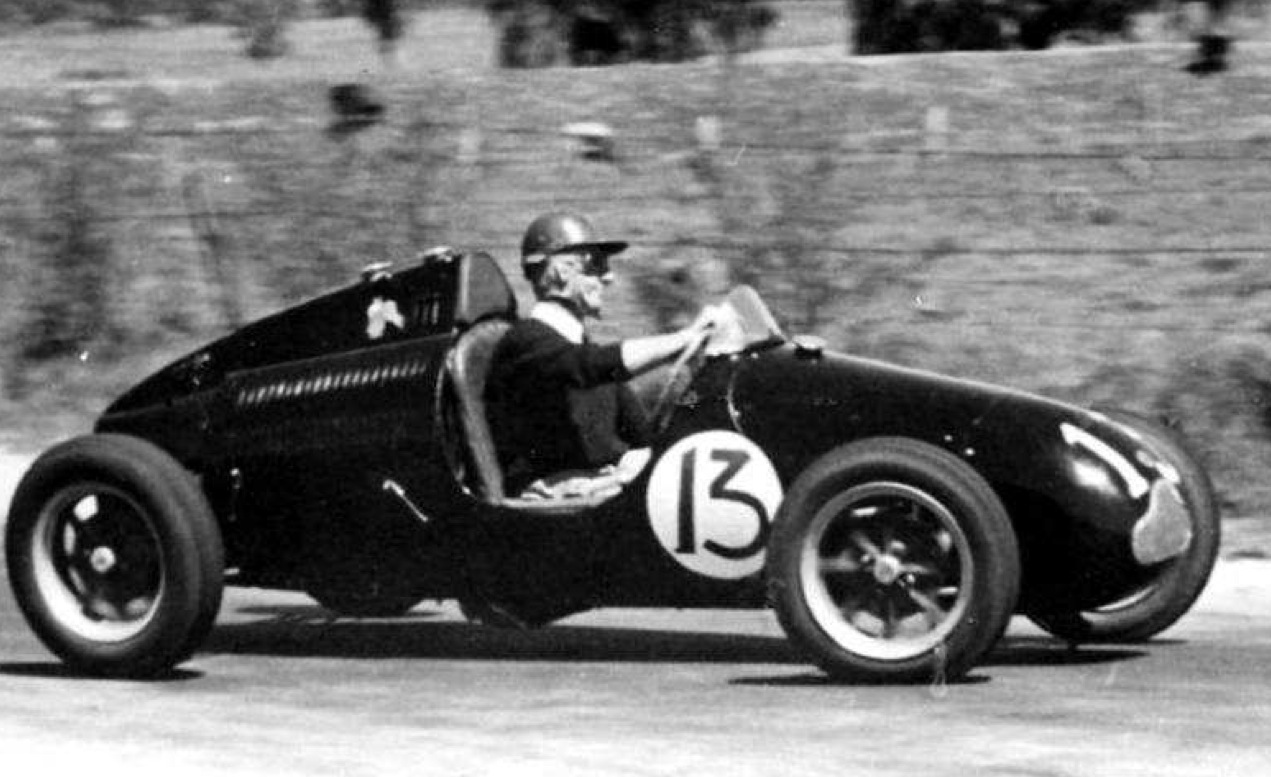
Its fascinating to get the insights of the day from a top driver of the comparison between ‘the old and new paradigms’ of front and mid engined cars…Cooper won their first Grand Prix in Argentina 1958, in Stirling Moss’ hands, himself a former Cooper 500 exponent.
The Monza was offered for sale by Edgerton in Australian Motor Sports in April 1951 and was bought by Toorak, Melbourne enthusiast Earl Davey Milne, it is still owned by the family and whilst in good hands and complete it remains disassembled and unrestored.
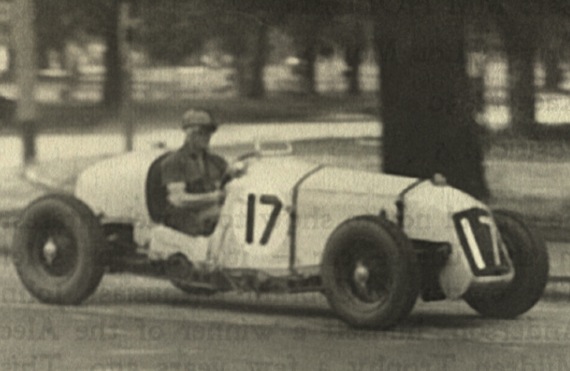
Alf made a comeback of sorts in the 1953 Australian Grand Prix, the first held at Albert Park.
Gib built a two-seater sports car called BWA, colloquially the ‘Bloody Work of Art’ pre-War but actually named after the car’s builders, Messrs Barrett/Ashton/White. The BWA was converted into a single-seater post war, the 1953 AGP regs allowed two drivers so Alf started the race and handed over to Gib.
It wasn’t their best of events, the pair lost 15 minutes at the start with fouled ‘plugs and then managed to set fire to it after a fuel spill at a pitstop. Still, they finished twelth, Doug Whiteford won the race in his first Talbot Lago T26C, it was his third and final AGP win. The Lago was as aristocratic as Black Bess, his 1950 AGP winner, was proletariat, having won the AGP at Bathurst in 1952 in the Lago as well.
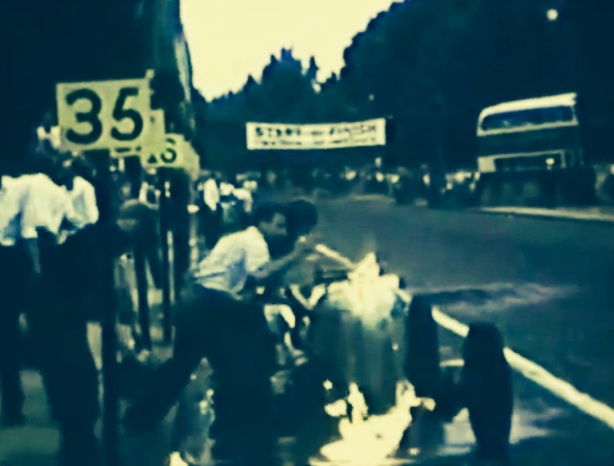
Barrett remained a motor racing enthusiast and in a neat bookend to his career commencement also finished it in a Morris.
He contested the 1969 Bathurst 500 in a Morris 1500 shared with Kyneton, Victoria motor dealer/racer Mel Mollison, they finished 37th. Barrett drove the car with the same verve and flair for which he was famous if not wearing the blue T-Shirt for which he was also renowned, he died in 1998.
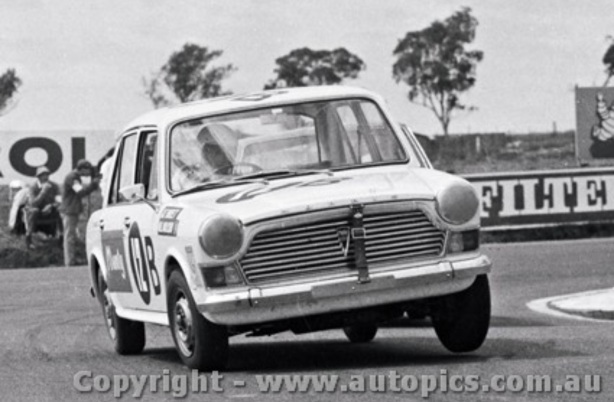
Etcetera…
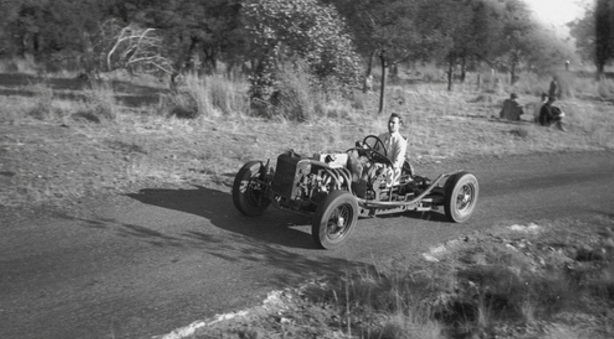
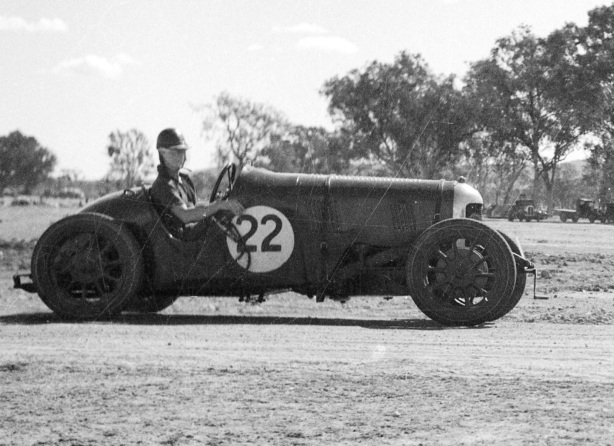
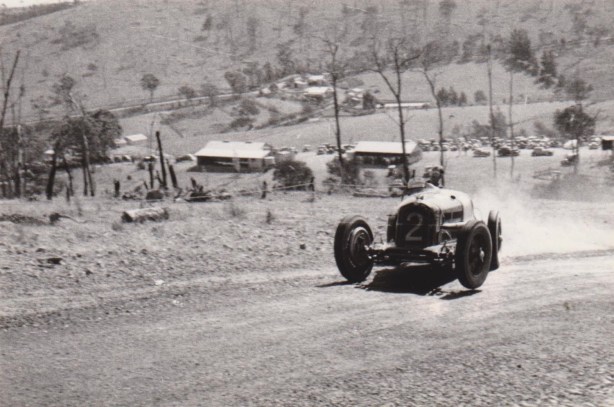


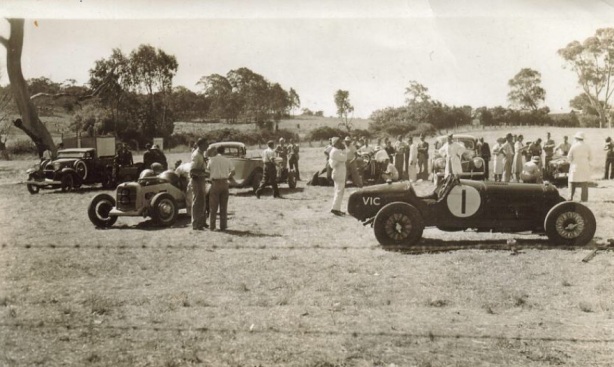
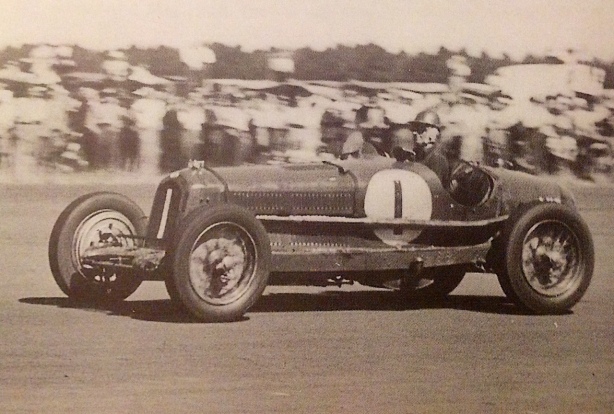

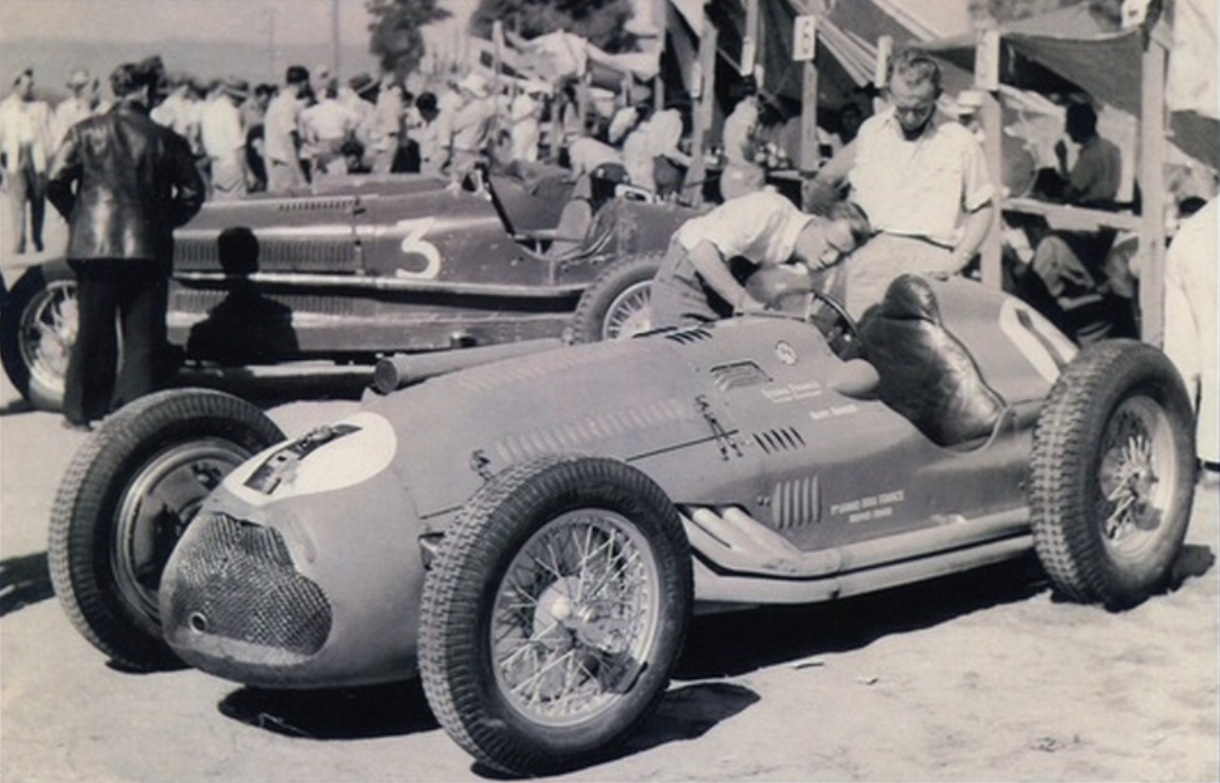
Monza # 2211134 History…
The following article was published in Motor Sport by Denis Jenkinson in 1976 with input from Earl Davey-Milne, a Melburnian who still owns the car. 
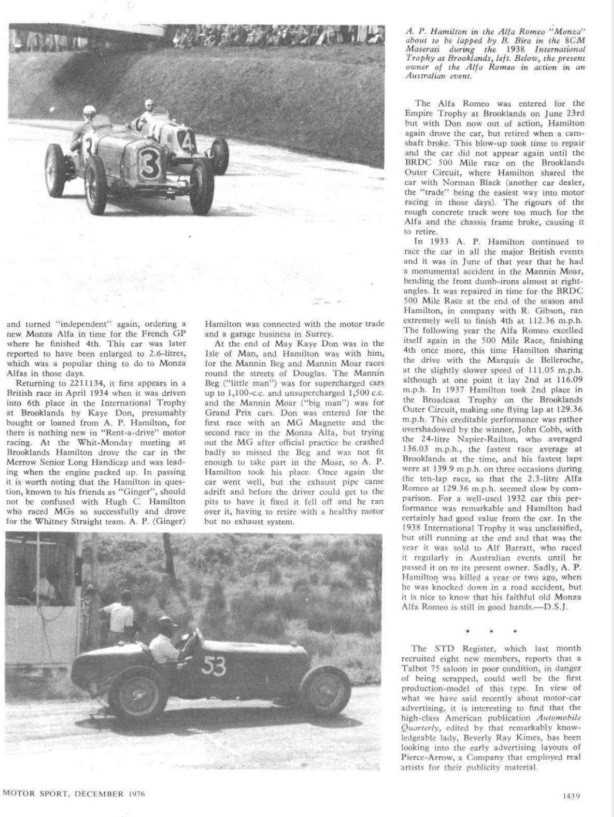
Bibliography and Credits…
John Medley in Graham Howard’s ‘History of The Australian Grand Prix’, John Blanden ‘Historic Racing Cars in Australia’, ‘Loose Fillings’ Winter 2012, Motor Sport, MotorMarque, Patrick Atherton Lagler Racing, ‘Cars and Drivers’, John Medley
John Blanden, George Reed, Dacre Stubbs Collection, John Blanden Collection, Ean McDowell, John Medley, autopics, State Library of Victoria, W J Farncourt, George Thomas, Byron Gunther, Norman Howard, Allan Griffin Collection, Bob King Collection, Tony Johns Collection
Tailpiece…

Finito…
Some car.
Yep,the funny thing is the car lives, and has done for the last 60 years, in the same suburb of Melbourne where I live on the weekends, but I haven’t ever seen it! It’s a big country. Ironic.
….a continent.
😉
[…] https://primotipo.com/2015/02/20/alf-barrett-the-maestro-alfa-romeo-8c2300-monza/ […]
Hi Mark, I’ve just discovered your amazing site I’m particularly interested in Alf Barrett I know his son Alf Junior who is over eighty and I would like to be able to reproduce the article Alf Barrett the Maestro for him I would also like to join the blog, Regards Col Johnson
Col,
Great to hear from you, and yes, please show Alf Jnr the article. I researched it as best I can but any first hand accounts of his Dad I would love to hear and incorporate into the article, or do a separate one of his recollections.
My partner lives in Toorak, I quite often have a steak and an ale at the Orrong Hotel only metres away from where the Monza was prepared by Alan Ashton at AF Hollins, 694 High Street, Armadale all those years ago!
My email is mark@bisset.com.au and mobile 0419-332342 should you want to get in touch.
Alf is a most fascinating character too little of substance is known about.
Regards,
Mark
I believe that the car identified in the 1940 Lobethal photo as the Jackson Motors Riley is actually the Jack Phillips Ford V8, winner of the 1940 South Australian Hundred, the main event at that meeting. The programme lists the Phillips Ford as No 8 and the Jackson Motors Riley as No 21.
Thanks Rob, the car looked nothing like a Riley did it! Nice to know what it is, where did Alf finish in the ‘100’? Thanks, M
Barrett recorded a DNF with a broken axle but did set the fastest lap of the race: 5 min 48 sec, 92 mph.
Thanks Rob, will add that to the caption. Just talking about this article reminds me a mate has leant me the Simon Moore 8C Alfa book, there is some great stuff from Gib Barrett on his brothers racing of the car, must sit down and transcribe it! Mark
Mark, I believe that Barrett won the Winter 100 at Phillip Island in 1935 rather than 1934 as stated above. Please refer to http://trove.nla.gov.au/newspaper/article/12245132
Cheers Rob,
It’s a long time since I wrote that one.
It reminds me I have a mates 8C2300 book here somewhere, there is a long section in it of Gib Barrett giving his recollections of the Monza. Have been meaning to drop that into the article. Expensive book too- I wonder where it is?!
Mark
Mark,
Reference is made above to the Monza racing “at the Bathurst October meeting in 1951, finishing 4th in the ‘100’ and 3rd in the 50 Mile ‘Redex Championship’.”Going by the report of the October meeting in the National Advocate, the 50 Mile race was the main event and there was no “100” race held at that meeting. However, the National Advocate report of the 26 March 1951 Bathurst meeting has the main race as the “Redex 100”. It also has R. Edgerton competing in the 100 in an Alfa Romeo, although it notes that only three drivers officially finished the race as “all other contestants failed to reach the finishing line within five minutes of the leader.” Edgerton is not listed as one of the three finishers. He may have been the fourth driver to complete the distance, but seems to have been a victim of the somewhat harsh regulations for the race.
Rob
Thanks Rob
Ron Edgerton is one of those guys who pops up quite a lot but not a lot has been written about- and raced and owned a lot of different cars. His story would be quite an interesting one I think.
Mark
Mark,
Regarding the image above captioned “Doug Whitefords’ Talbot Lago in front of the Monza, then owned by Ron Edgerton at Bathurst in 1954” – John Medley’s book “Bathurst – Cradle of Australian Motor Racing” has the same photo in the chapter on the Easter 1951 Bathurst meeting. That would mean that the #3 Alfa behind the Talbot is the Lex Davison car rather than the Edgerton machine, which ran as #2 at that meeting.
Medley notes that the badge is missing from the nose of Talbot and was actually imbedded in the tail of the Davison Alfa after a coming together in the “Over 1500cc Handicap”, a support event to the Redex 100 feature race.
Rob
Rob, the image is of 2211134 in the hands of Ron. Monza exhaust is on the near side while Lex’s car which was a P3, runs exhaust down the off side.
Mark, Ron Edgerton’s son Greville has information on Ron and is still about. I can supply contact details and other information. Bob
Bob,
be great to get in touch with him- in fact I’ve a few research challenges I would like to run past you, shall give you a call.
Mark
Hi Mark. A most interesting article. In the mid 60’s I worked at A F Hollins in the workshop preparing the cars for sale before moving into the sales department. I bought my first Mini Deluxe from Hollins which was fettled by Alan Ashton and Gib Barret , I raced this car beating many of the 998cc Mini Cooper cars at he time. Great days. Cheers Simmo.
Great to hear from you Simmo,
I get a sense of history whenever I have an ale at the Orrong Hotel, just opposite the old AF Hollins ‘shop, I guess it will be bowled over and turned into apartments one day. Very keen to sit down with you about your recollections of Alan Ashton- there is certainly a story to be written about the cars and clients that outfit looked after so successfully for so long. ‘Lex’s cars the end of it??
Mark
ps; enjoying my two new books purchased @ Melb Uni last weekend!
Mark,
Just a comment on that “October 1947” image of Barrett taking the checkered flag. I don’t believe this can be the finish of a preliminary race as suggested. According to John Medley’s “Bathurst, Cradle of Australian Motor Racing”, the AGP was the only race at the 1947 meeting. The AMS report on the race supports that. Another time and/or another place?
Rob
Thanks Rob,
That’s an oldie. At the time I wrote it I didn’t have Medley’s Bible but Martin Stubbs picked up a copy for me online, it’s one of my favourite books and along with his ‘John Snow’ book is an amazing resource for all manner of things other than just the racing. Will have a flick through at some point and see if I can work out a likely date.
There is not much written about Alf Barrett, which is a shame, I’m writing this in Armadale where he and his brother lived actually!
Mark
[…] Edgerton was immediately on the pace with it too. More on Ron’s time in this car soon, in the meantime it’s story is told, at length, here; https://primotipo.com/2015/02/20/alf-barrett-the-maestro-alfa-romeo-8c2300-monza/ […]
[…] The shot is all about people. Alf Barrett is sitting behind his car in the bright, white open shirt. Checkout the white-suited car salesman with natty shoes at right, and interested spectators. See here; https://primotipo.com/2015/02/20/alf-barrett-the-maestro-alfa-romeo-8c2300-monza/ […]
[…] And the same shot, at Mount Panorama, below colourised by Nathan Tasca, the muted tones are much to my liking. See here for an epic on car and driver; Alf Barrett, ‘The Maestro’, Alfa Romeo 8C2300 Monza… | primotipo… […]
[…] Barrett crossed the line in the fastest time to win from Snow and Whatmore – then George Reed Ford V8 Spl, the John Crouch Alfa, Frank Kleinig, Paul Swedberg, John Barraclough, and Jack Phillips/Parsons Ford V8 Spl. Barrett set a lap record during the race at 3 minutes 4 seconds. Click here for a lengthy feature on Barrett and his Alfa; Alf Barrett, ‘The Maestro’, Alfa Romeo 8C2300 Monza… | primotipo… […]
I’m quite chuffed you found and quoted from my website, which was nothing more than a personal interest job in between races when I was into superkarts. Before it disappeared into web archives, I re-created it on a wordpress site, but thanks for preserving a part of it. I thought the only people who read it were my sponsor, one or two fellow-nostalgia-buff teammates, and my mum. Lobethal has always held a special place for many racing tragics, not just from SA. It’s a timeless story.
But your site has amazing depth and coverage of all things motorsport nostalgia, I’m glad I found it. Keep up the great work. Patrick A
Cheers Patrick,
The power of the internet my friend. It’s amazing what pops-up in a Google search!
Its funny, my various Lobethal pieces get consistent hits, its one of those places that enthusiast s globally trip over eventually. Ditto Longford.
regards,
Mark
[…] See here for more: https://primotipo.com/2015/02/20/alf-barrett-the-maestro-alfa-romeo-8c2300-monza/ […]